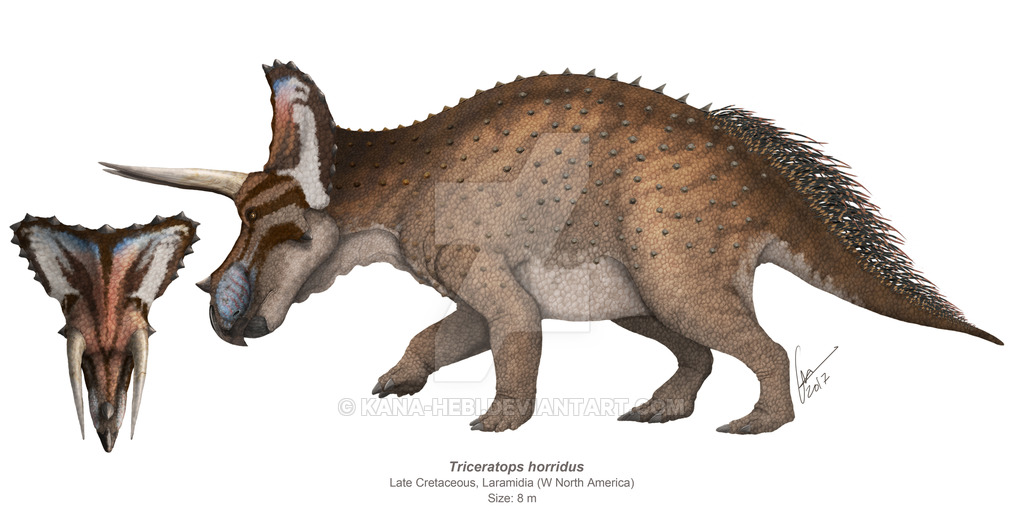Triceratops horridus
Triceratops horridus is a large herbivorous species that encounters itself high in the food web of Mesos. They can be found in herds or solitary all through the eastern zone of the continent all year and seasonally migrate west for reproduction purposes.
These animals become easily aggressive when provoked, and should never be bothered or harassed.Common Names
- English: Stonfrills
Basic Information
Anatomy
Triceratops horridus reaches lengths of 8 to 9 meters from beak to tail and up from 2.5 to 3.5 meters in height to their shoulder in both genders.
Their most distinguishable trait are their heads. They have a large skeletal frill in the rear of their skulls, adorned with epoccipitals which are more pronounced in males. Triceratops horridus have three horns: two large horns of around 1 meter long which are on top of their eyes and point horizontally and one smaller horn of around 20 to 50 centimeters on top of their nostrils pointing vertically.
Triceratops horridus are muscly, sturdy animals. Their body is quite spherical and have a good capacity to sustain fat. They have strong arms with three hooves each and strong legs and short strong legs with four hooves each, with their fingers pointing out and away from the body. They are quadrupedal, walking with their four limbs straight from the ground. However, when faced with a threat, they sprawl their arms with an angle from their thorax to lower their heads and expose their horns.
Their skin is tough and thick. The skin is mainly scaly and could reach thicknesses of 10 centimeters. It possessed osteoderms along the back and tail. Triceratops horridus had quill-like scales on their backs, increasing on size as they reached the tail.
Genetics and Reproduction
To copulate, a bull needs to be paired to a cow. If a bull is unpaired, by the beginning of fall, it will try to pair with a cow of its preference.
At the end of fall, Triceratops couples copulate in an action called a "cloacal kiss". They will make their cloacas touch each other and the male will impregnate the female.
Once winter starts, Triceratops horridus migrate west through Deas to reach the plains in the other side of the continent by spring. There, females make nests and lay around 3 to 6 eggs. Eggs hatch by the end of spring. Unpaired females tend to reproduce with the patriarch before marching east.
Growth Rate & Stages
Hatchlings have a very spherical body. Their legs barely let them discover around the nest. They possess very small horns and big eyes relative to their bodies. Mothers take active care of them. Juveniles differ from hatchtlings mainly on their size and activity. They become more vocal and show the first signs of dominance and personality.
A youngster passes from juvenile to subadult when they show the first signs of sexual dimorphism. Males start showing distinct colors on their frills while females show non. They can also be easily difference from other stages by their horns which grow long and upwards.
Male Triceratops horridus reach sexual maturity at 4 months old and females reach fertility at 8 years old. However, Bulls tend to reproduce for the first time by 5 years old and females by 10 years old. Adults can be easily distinguished from other stages for their long horizontal horns and their very remarked frill. They become sexually active and protect the herd from predators.Ecology and Habitats
Dietary Needs and Habits
Additional Information
Social Structure
Triceratops live typically in herds lead by a matriarch and guarded by a patriarch. Other bulls follow the herd from a far, using their sense of smell to keep their track.
Bulls who feel empowered enough tend to challenge the patriarch during fall for its position. Bulls challenge each other before starting a fight. They walk in circles following the tail of their opponent in a circle of around 12 meters in diameter. As they walk, they move their heads in a motion that makes their frill stand out, growl and even shout. After some minutes, if no contestant has surrended, they start a charge fight.
When in a charge fight, Triceratops face each other at a distance of around 10 meters. They paw the ground and charge at their best speed. They impact themselves with their heads and push each other. The winner of each charge is usually either the one who pushed more or whoever didn't got exhausted. After several charges one of the fighters surrenders, runs off and shouts with a sound characteristical of trikes when they feel danger.
Reasons to fight other than to be in the patriarch position are to fight for a paired female after an unpaired male has impressed her. They do this by moving their frill and making gentle sounds. If the female accepts, she returns the gentle sounds and get close to the male. In cases where the female will reject the male, they will become aggresive to them by mock charging. However, if the female is already paired to another male, the paired bull will try to scare off the rival. If it doesn't, the unpaired male will challenge the paired bull to a fight. If the paired male accepts the challenge, they will the start a charge fight. The winner of the charge fight can stay with the female, if she accepts him.
Unpaired bulls don't migrate and stay solitary of the herds as they migrate east. However, unpaired females migrate with their herds as they usually reproduce with the patriarch before the migration.
Perception and Sensory Capabilities
Symbiotic and Parasitic organisms
Remove these ads. Join the Worldbuilders Guild









Comments